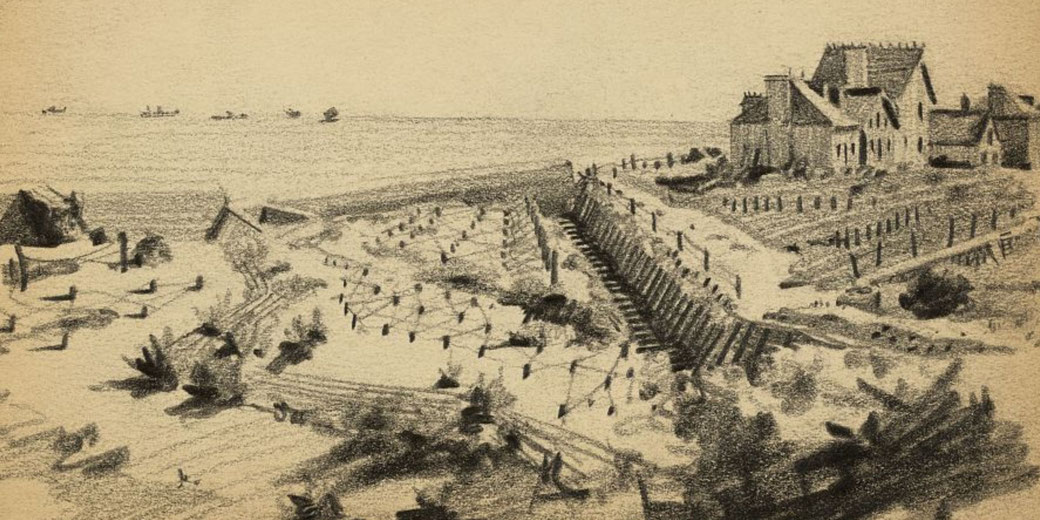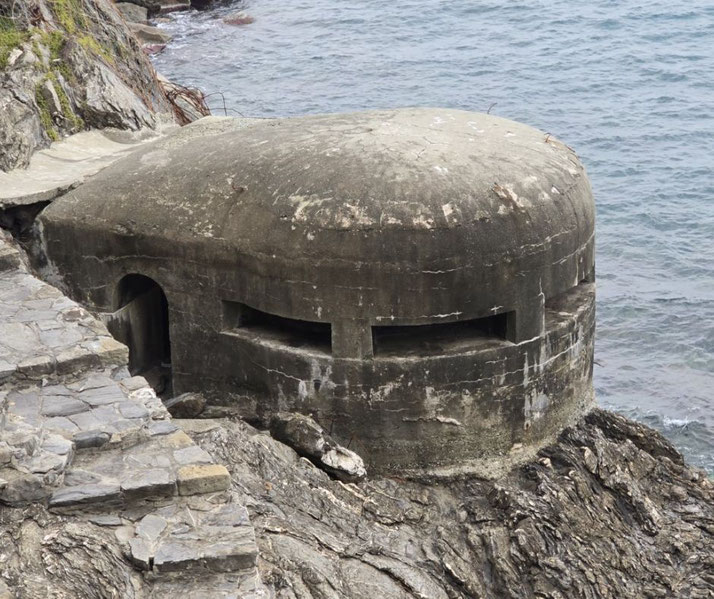The Atlantic Wall: Hitler's failed fortress against the Allies

The Atlantic Wall was a sprawling network of fortifications stretching from Norway to the Spanish border, and it stands as one of the most ambitious military engineering projects of the 20th century.
Conceived by Adolf Hitler as a formidable barrier against an anticipated Allied invasion, the wall was intended to be the linchpin in the defense of what the Nazis called "Festung Europa," or Fortress Europe.
Yet, despite its grand scale and the resources poured into its construction, the Atlantic Wall is perhaps best remembered for its failure to prevent the Allied landings on D-Day, a pivotal moment that marked the beginning of the end for Nazi Germany.
How Hitler dominated western Europe
By the early 1940s, Nazi Germany had already annexed Austria, occupied Czechoslovakia, and invaded Poland, triggering a global conflict.
The Blitzkrieg tactics employed by the Wehrmacht had proven devastatingly effective, leading to the rapid capitulation of countries like France, Belgium, and the Netherlands.
Hitler's vision of a German-dominated Europe seemed increasingly plausible, and the occupation of Western Europe was a critical step in consolidating that vision.
Yet, even as the Axis powers expanded their territorial gains, the limitations of their military reach were becoming apparent.
The failure to subdue the United Kingdom during the Battle of Britain and the quagmire of the Eastern Front against the Soviet Union signaled that the war was far from won.
What was the purpose of the Atlantic Wall?
By 1942, it was becoming increasingly clear to the German High Command that the tide of World War II was not flowing entirely in their favor.
The Eastern Front against the Soviet Union had turned into a draining war of attrition, and the Battle of Britain had demonstrated that the Luftwaffe alone could not subdue the United Kingdom.
With the United States entering the war, the Axis powers faced the daunting prospect of a two-front conflict.
Hitler, ever the strategist, recognized that defending the extensive coastline of occupied Europe would be a Herculean task, one that required a permanent solution.
Thus, the idea of the Atlantic Wall was born, not merely as a military fortification but as a symbol of the impenetrable "Fortress Europe" that Nazi propaganda was so keen to project.
Hitler's vision of a German-dominated Europe was predicated on the notion of territorial inviolability.
The Atlantic Wall was to serve as a physical manifestation of this vision, a concrete and steel bulwark that would deter any attempts to reclaim occupied territories.
It was a statement of intent, aimed as much at the German populace and the occupied countries as it was at the Allied powers.
The wall was designed to send a clear message: Fortress Europe was a reality, and any attempts to breach it would be met with overwhelming force.
How the Atlantic Wall was built
Initiated in 1942, the wall was designed to stretch from the Arctic Circle in Norway down to the Spanish border, covering a distance of over 1,600 miles.
The project was overseen by Organisation Todt, a civil and military engineering group that had previously been responsible for other monumental projects like the Autobahn.
Under the direction of Albert Speer, Hitler's Minister of Armaments and War Production, the Atlantic Wall became one of the largest construction endeavors of the 20th century.
It was a complex of bunkers, artillery placements, minefields, and anti-tank obstacles, all designed to form a cohesive and formidable defensive line.
The labor force required for such an ambitious project was immense. While German military engineers provided the technical expertise, the bulk of the construction was carried out by a diverse workforce that included German civilians, prisoners of war, and forced laborers from occupied countries.
The use of forced labor was a dark chapter in the wall's history, as thousands were compelled to work in often brutal conditions, with little regard for their well-being.
This labor force worked around the clock, pouring concrete, laying mines, and erecting fortifications.
The scale of the project was so vast that it consumed an estimated 17 million cubic meters of concrete and over a million tons of steel.
These resources were diverted from other critical areas, a decision that was the subject of internal debate within the German High Command.
As the wall took shape, it became clear that it was not a uniform line of defense but rather a series of fortifications of varying quality and strength.
Some sections, particularly around key ports and potential landing sites like Pas-de-Calais and Normandy, were heavily fortified.
Others, especially in less strategically important areas, were less robust. This unevenness was partly a result of resource constraints and partly due to differing assessments within the German military about where an invasion was most likely to occur.

How the Atlantic Wall was meant to work
The wall was designed to be a multi-layered defense system that included coastal artillery, anti-aircraft guns, minefields, and a variety of obstacles intended to impede both landing craft and infantry.
The fortifications were strategically placed to provide overlapping fields of fire, allowing German defenders to engage invading forces from multiple angles.
Coastal batteries were equipped with heavy artillery capable of targeting ships at sea, while anti-aircraft installations aimed to deter or destroy airborne landings.
The idea was to create a lethal killing zone that would break the momentum of any invasion force as it tried to move inland.
Field Marshal Erwin Rommel, who was given the responsibility of strengthening the Atlantic Wall in 1943, brought a new sense of urgency and tactical innovation to its defenses.
Rommel believed that the invasion would be decided on the beaches and that preventing the Allies from establishing a foothold was paramount.
To this end, he ordered the construction of numerous obstacles on the beaches themselves, including hedgehogs and Czech hedgehogs, designed to rip the hulls of landing craft.
He also initiated the placement of "Rommel's Asparagus," tall poles intended to disrupt airborne landings, and had them installed in fields behind the beaches.
Rommel understood that time was of the essence in repelling an invasion; the longer it took the Allies to move off the beaches, the more time German reinforcements would have to arrive and counter-attack.
How the Allies planned to break through
The Allies spent months gathering intelligence about the wall's defenses, employing a range of methods from aerial reconnaissance to the use of French Resistance networks.
This intelligence was crucial in shaping Operation Overlord, the overall plan for the invasion of Europe, and its seaborne component, Operation Neptune.
The plans called for a multi-pronged assault on a 50-mile stretch of the Normandy coast, involving over 156,000 troops and thousands of ships and aircraft.
But to succeed, the Allies knew they had to mislead the Germans about their true intentions, thereby preventing them from concentrating their forces at the invasion points.
Operation Fortitude was the deception plan designed to achieve this objective, and it was executed with a level of detail and creativity that was nothing short of brilliant.
Fortitude consisted of two main components: Fortitude North and Fortitude South.
Fortitude North aimed to convince the Germans that an invasion of Norway was imminent, forcing them to divert troops and resources away from France.
Fortitude South, on the other hand, was designed to make the Germans believe that the main invasion force would land at Pas-de-Calais, the narrowest point between Britain and France and therefore the most logical site for an invasion.
To lend credibility to these deceptions, the Allies created entire phantom armies, complete with inflatable tanks and fake radio traffic.
The Germans took the bait. Fooled by the elaborate ruses, they kept significant forces in Norway and maintained strong defenses at Pas-de-Calais, even after the Normandy invasion had begun.
Hitler was so convinced that Normandy was a diversion that he delayed the release of reserve Panzer divisions, providing the Allies with a crucial window of time to establish a beachhead.
The Atlantic Wall and the D-Day landings
On June 6, 1944, known as D-Day, the Allied forces launched Operation Overlord, the invasion of Nazi-occupied Europe, with the aim of breaching the formidable defenses of the Atlantic Wall and establishing a foothold on the continent.
The operation involved over 156,000 troops, more than 5,000 ships, and 11,000 aircraft, making it one of the largest amphibious assaults in history.
The invasion targeted five beaches along a 50-mile stretch of the Normandy coast: Utah, Omaha, Gold, Juno, and Sword.
Each beach presented its own set of challenges, from the heavily fortified cliffs of Omaha to the extensive flooding of fields behind Utah, but the overarching goal was the same: to break through the Atlantic Wall and pave the way for the liberation of Europe.
First, in the early hours of D-Day, paratroopers from the 82nd and 101st Airborne Divisions were dropped behind enemy lines to secure key roads and bridges, but many landed off-target, leading to scattered engagements throughout the Normandy countryside.
Naval bombardments aimed to soften the coastal defenses, but they were not as effective as hoped, leaving many German fortifications intact.
As the landing craft approached the beaches, they faced a hailstorm of bullets, artillery fire, and underwater mines.
Casualties were particularly high at Omaha Beach, where well-placed German defenses inflicted heavy losses on the American troops.
Yet, despite these obstacles, the Allies persevered. Ingenious engineering solutions, like the Mulberry Harbors and the "Hobart's Funnies" specialized tanks, helped overcome logistical challenges, while the bravery and determination of the individual soldiers carried the day.
By the end of June 6, the Allies had succeeded in securing all five beachheads, albeit at the cost of approximately 10,000 casualties.
The Atlantic Wall, which had been touted as an impenetrable barrier, had been breached.
The Germans, misled by Operation Fortitude and hampered by indecisive leadership, failed to mount an effective counterattack in the crucial early hours of the invasion.
Hitler's hesitation to release reserve Panzer divisions for a counteroffensive proved to be a costly mistake, giving the Allies the time they needed to pour more troops and resources into Normandy.
Over the ensuing weeks, the beachheads were expanded, and the Allies began the arduous campaign to liberate France and the rest of Europe.
What do you need help with?
Download ready-to-use digital learning resources
Copyright © History Skills 2014-2025.
Contact via email
With the exception of links to external sites, some historical sources and extracts from specific publications, all content on this website is copyrighted by History Skills. This content may not be copied, republished or redistributed without written permission from the website creator. Please use the Contact page to obtain relevant permission.





